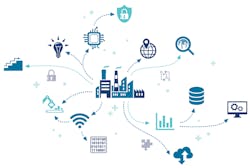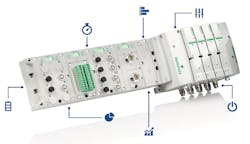The past few years have witnessed significant interest around the Internet of Things (IoT) and Industry 4.0. In the manufacturing world, the concept is often referred to as the Industrial Internet of Things (IIoT) and it is noticeably making gains in every corner of the factory floor. Enhanced computing power and the advent of big data is helping to turn the promise of IIoT into reality—connected components within larger systems that bring machine intelligence to the device level.
The point is to seamlessly gather data, analyze it on the fly and turn that information into actionable results that increase uptime, efficiency and productivity.
From robotic systems and highly automated assembly lines to discrete components like pneumatic valves and actuators, IIoT is working its way into the fabric of today’s manufacturing environment across nearly every industry. Medical device assembly, automotive production, food processing and numerous packaging applications are all beginning to reap the benefits of connecting smarter devices with onboard intelligence.
Plants don’t always have the necessary infrastructure due to competing IoT standards such as EtherNet/IP, Profinet, and others.
Data Analytics and Actionable Results
Modern production environments with dynamic machinery and automated equipment are beginning to rely ever more heavily on real-time data analysis. IIoT enables up-to-the-minute assessments via an extensive network of smart sensors that allow pervasive, system-wide data harvesting based on a robust communication backbone infrastructure. In this way, large amounts of data are continuously gathered from the component and device level of the factory floor environment. Once collected, this raw data is analyzed and turned into useful information. Smarter devices than those installed even a few years ago are now required to support real-time local analytics, device analytics, and system-level intelligence, including both edge and cloud computing strategies.
The goal of data gathering and analysis is to convert all of that activity into actionable results. This simply means using the information gleaned from analyzing device-level data to improve overall equipment effectiveness or OEE—in other words, maximizing productivity and minimizing (or even eliminating) unplanned downtime. The concept is straightforward and offers numerous benefits, such as higher yields and improved quality, a holistic view of system integrity, better inventory control, lower cost of ownership due to energy optimization and the ability to access analytic results remotely on a 24/7 basis. The capacity to gather and use data to drive decisions that directly impact productivity is the very essence of IIoT.
For example, consider the impact IIoT is beginning to have on the packaging industry. Enabled by smart components supported by the appropriate computing and network infrastructures, manufacturing problems could be prevented before they even occur. Imagine a smart pneumatic device, for example, that could report a clogged or dirty filter before it gets bad enough to slow or halt a packaging process. The goal is to make the shift from a merely diagnostic capability and mentality to one that is truly prognostic and forward-looking.
Another way to look at this productivity evolution is to think about it as a journey from reactive to preventive to predictive maintenance. IIoT data gathered at the device level can be used to drive improvements in machine reliability in terms of availability (maximum run time), performance (ideal cycle time), and quality (good part count with minimal scrap).
Future-proof IoT platforms start with embedded intelligence at the device level that can enable local analytics.
Implementing IIoT
Although the potential benefits of a well-executed IIoT system are extremely promising in terms of productivity improvements, the path to full implementation is not without challenges. First, the basic infrastructure is still evolving. By its very nature, IIoT generates a tremendous volume of data that must be aggregated, analyzed, and then acted upon. Manufacturing applications require real-time data that calls for an entirely new class of components—those with dedicated device-level intelligence. Both edge and cloud-based computing strategies need infrastructure capable of handling the new realities of big data, and these systems are still taking shape.
In addition to the work-in-progress status of today’s IIoT landscape, standards are equally haphazard. The reality is that no unified standard exists to drive IIoT infrastructure on a global basis. From Industry 4.0 and the Industrial Internet Consortium to China Manufacturing 2025 and Smart Factories, various regional and industry-specific strategies exist when it comes to developing IIoT standards. Add that to the usual decisions around industrial communication protocol choices such as Ethernet/IP, Profinet, IO-Link, and others. The result is a patchwork IIoT infrastructure spread across the broad manufacturing world.
Device-Level Analytics
The evolution of IIoT standards and infrastructure are largely being driven by PLC manufacturers. Therefore, one platform that is truly future-proof starts with embedded intelligence at the device level. For example, consider a pneumatic fieldbus valve manifold such as the ASCO Numatics G3 platform, which extends intelligence to perform a variety of IIoT data analytics locally—at the device level. This approach offers several benefits.
First, it provides the ability to gather relevant and useful information on smart pneumatic devices regardless of overall plant infrastructure. Further, no changes are required to the PLC program because diagnostic and prognostic information-gathering happens at the device level. This is also a technically superior approach due to computing power at the device level that enables analysis of sensor-level data in real time. In addition, as the IIoT infrastructure develops and matures, the device-level information stays relevant. Finally, this strategy allows predictive maintenance today due to the availability of device prognostic data.
When properly analyzed, IIoT data can lead to the right kind of prognostic information that makes true predictive maintenance a reality. This in turn allows for accurate predictions involving machine performance and avoidance of component and system failures. All of this data analysis translates to reductions in downtime, lower maintenance and inventory costs, improved machine health, higher and better-quality yields, and increased equipment effectiveness and productivity.
Device analytics can gather relevant and useful information on smart pneumatic devices regardless of plant infrastructure.
Smarter Pneumatics
Achieving the full promise of IIoT and significantly improved productivity benchmarks is going to require smarter devices across the entire manufacturing spectrum. Let’s consider a scenario with a modular, scalable, distributed I/O system integrated into a pneumatic valve manifold used in applications such as bottling, packaging, and medical device assembly. In this setup, both centralized and distributed applications use the same modules to increase flexibility and reduce complexity. On the manifold, an integrated graphic display is used for configuration and point-of-use diagnostics—and now prognostics. Finally, adding device analytics makes the valve manifold “smart” and capable of making a real impact on productivity.
One of the chief benefits of device-level analytical capabilities is that they can circumvent the PLC. This means zero programing changes to the PLC and no data mapping required. However, it is still possible to map data to the PLC as needed. In addition, with an integrated web server and LCD display, it’s easy for plant personnel to check on device health either in person or by using a simple app on a mobile device. Apps are able to promptly report critical issues that affect machine and component functions, heading off larger problems that may otherwise go unchecked. Finally, although higher-level computing resources are not required for device-level intelligence, edge and cloud computing are both supported by many of today’s smart devices.
Properly analyzing IoT data lets plant managers accurately predict and avoid component and system failures, thus reducing downtime and increasing OEE.
IIoT in Action
Let’s take a closer look at what type of information can be collected at the pneumatic device level. Smart valve manifolds are able to capture and analyze data to monitor the performance of parts such as valve cylinders and filter regulator lubricator (FRL) filters, in addition to keeping tabs on critical parameters such as air leaks and mission time. Following are a few examples of IIoT in action at the device level:
Monitoring valve cylinder performance. Smart valve manifolds with device analytics are able to track the time it takes for the cylinder to extend and retract. The manifold then determines if the cylinder extend/retract time varies by a previously user-determined percentage. If the variance exceeds the preset threshold, the manifold warns the user so corrective action can be taken before productivity is affected. The key here is that no PLC action is required and existing cylinder sensors may be used.
Tracking pressure variances over time. Intelligent valve manifolds with device analytics can also be used to monitor the efficiency of the filter element—again, with no PLC involvement needed. The manifold sends a message to the user when the filter element needs attention or replacement. In other words, the warning is sent before machine performance is compromised.
Implementing edge computing. Edge computing gateways expand data management, aggregation, and analysis capabilities across multiple devices into the system level. Application development is simplified via Node-RED graphic tools. Pre-packaged smart pneumatics solutions are available and do not require cloud computing, although the cloud can be used if desired. Node-RED is a visual, flow-based programming tool for IIoT, with more information available at nodered.org.
These are just a few simple examples of what IIoT can accomplish today at the device level in terms of pneumatic components. In the short term, onboard device analytics can offer connectivity and analysis. Taking IIoT to the next level will involve an edge computing strategy where an infrastructure edge gateway device will enable system analytics. The long-term view will involve cloud computing and true enterprise-level analytics.
As billions of smart devices continue to join the IoT framework and 5G begins to be commercially deployed on a global basis, IIoT strategies across the manufacturing world will strive to keep pace. There is no reason to delay testing the IIoT waters with device-level intelligence as a first step.
Enrico De Carolis is vice president of Global Technology at Emerson.





